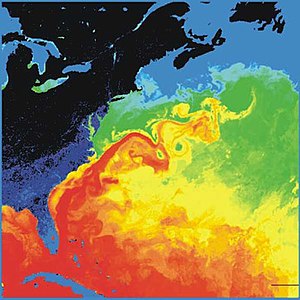
Back Golfstroom AF تيار الخليج Arabic Corriente del Golfu AST Qolfstrim cərəyanı AZ Гольфстрим BA Goifstrom BAR Гальфстрым BE Гальфстрым BE-X-OLD Гълфстрийм Bulgarian উপসাগরীয় সমুদ্রস্রোত Bengali/Bangla

The Gulf Stream is a warm and swift Atlantic ocean current that originates in the Gulf of Mexico and flows through the Straits of Florida and up the eastern coastline of the United States, then veers east near 36°N latitude (North Carolina) and moves toward Northwest Europe as the North Atlantic Current. The process of western intensification causes the Gulf Stream to be a northward-accelerating current off the east coast of North America. Around 40°0′N 30°0′W / 40.000°N 30.000°W, it splits in two, with the northern stream, the North Atlantic Drift, crossing to Northern Europe and the southern stream, the Canary Current, recirculating off West Africa.
The Gulf Stream influences the climate of the coastal areas of the East Coast of the United States from Florida to southeast Virginia (near 36°N latitude), and to a greater degree, the climate of Northwest Europe. A consensus exists that the climate of Northwest Europe is warmer than other areas of similar latitude at least partially because of the strong North Atlantic Current.[1][2][3] It is part of the North Atlantic Gyre. Its presence has led to the development of strong cyclones of all types, both within the atmosphere and within the ocean.